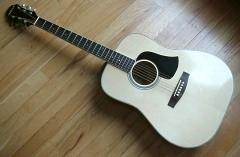An acoustic guitar is a guitar that uses only acoustic methods to project the sound produced by its strings. The term is a retronym, coined after the advent of electric guitars, which rely on electronic amplification to make their sound audible.
In all types of guitars the sound is produced by the vibration of the strings. However, because the string can only displace a small amount of air, the volume of the sound needs to be increased in order to be heard. I
n an acoustic guitar, this is accomplished by using a soundboard and a resonant cavity, the sound box. The body of the guitar is hollow. The vibrating strings drive the soundboard through the bridge, making it vibrate. The soundboard has a larger surface area and thus displaces a larger volume of air, producing a much louder sound than the strings alone.
As the soundboard vibrates, sound waves are produced from both the front and back faces. The sound board provides both a support for the sound board and a resonant cavity and reflector for the sound waves produced on the back face of the soundboard.
The air in this cavity resonates with the vibrational modes of the string and at low frequencies, which depend on the size of the box, the chamber acts like a Helmoltz resonator, increasing or decreasing the volume of the sound again depending on whether the air in the box is moving in phase or out of phase with the strings.
When in phase, the sound is increased by about 3 decibels and when in opposing phase, it is decreased about 3 decibels. As a Helmholtz resonator, the air at the opening is vibrating in or out of phase with the air in the box and in or out of phase with the strings. These resonance interactions attenuate or amplify the sound at different frequencies, boosting or damping various harmonic tones.
Also, the air in the box is coupled to the resonance of the top plate. Together, which cause further interactions. The back of the guitar will also vibrate to a lesser extent, driven by the air in the cavity. Some sound is ultimately projected through the sound hole[1] (some variants of the acoustic guitar omit this hole, or have f holes, like a violin family instrument).
This sound mixes with the sound produced by the front face of the soundboard. All these complex air coupling interactions, along with the resonant properties of the panels, are a key reason that different guitars will have different tonal qualities. The sound is a complex mixture of harmonics that give the guitar its distinctive sound.
In all types of guitars the sound is produced by the vibration of the strings. However, because the string can only displace a small amount of air, the volume of the sound needs to be increased in order to be heard. I
n an acoustic guitar, this is accomplished by using a soundboard and a resonant cavity, the sound box. The body of the guitar is hollow. The vibrating strings drive the soundboard through the bridge, making it vibrate. The soundboard has a larger surface area and thus displaces a larger volume of air, producing a much louder sound than the strings alone.
As the soundboard vibrates, sound waves are produced from both the front and back faces. The sound board provides both a support for the sound board and a resonant cavity and reflector for the sound waves produced on the back face of the soundboard.
The air in this cavity resonates with the vibrational modes of the string and at low frequencies, which depend on the size of the box, the chamber acts like a Helmoltz resonator, increasing or decreasing the volume of the sound again depending on whether the air in the box is moving in phase or out of phase with the strings.
When in phase, the sound is increased by about 3 decibels and when in opposing phase, it is decreased about 3 decibels. As a Helmholtz resonator, the air at the opening is vibrating in or out of phase with the air in the box and in or out of phase with the strings. These resonance interactions attenuate or amplify the sound at different frequencies, boosting or damping various harmonic tones.
Also, the air in the box is coupled to the resonance of the top plate. Together, which cause further interactions. The back of the guitar will also vibrate to a lesser extent, driven by the air in the cavity. Some sound is ultimately projected through the sound hole[1] (some variants of the acoustic guitar omit this hole, or have f holes, like a violin family instrument).
This sound mixes with the sound produced by the front face of the soundboard. All these complex air coupling interactions, along with the resonant properties of the panels, are a key reason that different guitars will have different tonal qualities. The sound is a complex mixture of harmonics that give the guitar its distinctive sound.
Here Acoustic Guitar selection :

No comments:
Post a Comment